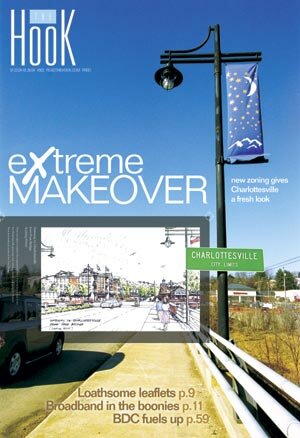Extreme makeover: Ordinance offers city a new look

PHOTOS BY JEN FARIELLO
On ABC's reality show Extreme Makeover, contestants who've never had to worry about winning beauty contests retreat for a six-week ultimate makeover, generally including liposuction, implants of every stripe, and porcelain veneers to disguise yellowed, jagged chompers.
Now, it seems, the city of Charlottesville may be poised for an extreme makeover of its own– under a new zoning ordinance that took effect in September. But does the city really need the makeover, which admittedly could be decades in coming?
The result of years of discussion among city planners, government, and citizen groups, the new ordinance is the very first total overhaul since the original zoning ordinance was introduced in the early 1950s.
How did such a "makeover" come about?
The city commissioned a "commercial corridor study" in the late 1990s to help determine ways to improve land use and allow for growth within the tight city limits.
Mixed-use developments, the city decided, are the wave of the future.
And like the snaggle-toothed smiles of makeover contestants, Charlottesville's corridors– those entries to our city that offer first and last impressions– may need veneers to maximize our city's appeal.
Those veneers, according to the study, will turn the corridors into vibrant areas where people live, work, shop, and play. Once the density is high enough, new types of mass transportation may become viable.
In the final corridor study, various renderings offer a glimpse of what Charlottesville's "after" might look like.

The rendering shows possible changes to the scene you'd see driving south on Emmet Street, approaching Barracks Road. ALC Copies: gone. The Meadowbrook Shopping Center has been completely rebuilt and moved roadside to provide window shopping even from your car– er, bicycle.
Curious? The answer, in a nutshell: brick, brick, and more brick. Lots of mini-Downtown Malls, with wide pedestrian corridors, big bike lanes, and ample plantings.
Mayor Maurice Cox is quick to reassure that the city wants to maintain diversity in development. The renderings, he says, are simply artistic interpretations of what might work at a particular location– they don't constitute any sort of final plan. Others, such as developer Oliver Kuttner, worry that the city is trying to enforce uniformity.
"They want everything matching," says Kuttner. "Those are not just renderings." [See sidebar on Kuttner.]
Whatever the case, the large-scale city makeover encouraged by the new ordinance should make for some edge-of-your-seat moments in the years to come. Be sure you're tuned in.

Maurice Cox
Mayor Maurice Cox, an architect with the RBGC Architecture firm, believes the new zoning ordinance is a crowning glory for Charlottesville.
"To purposefully rig the rules toward creating a mixture of uses," says Cox, "is a very significant achievement."
He says that by putting businesses and residences together, "we are ultimately changing people's habits."
By habits, Cox is referring to people's insistence on driving everywhere. Creating mixed-use areas, Cox says, is the first step toward creating a city where public transportation and pedestrianism finally trump the automobile.
"People are going to have to make fewer trips to get to work, buy groceries, and get to cultural offerings," Cox explains. "Some people call it density; it ultimately is a decision about proximity."


Giovanna Galfione
When Galfione, an architect with RBGC (and wife of the Mayor), took on the former Woolworth's building project, she says, she had her work cut out for her: At 66,000 square feet, the building would be larger than any other on the Downtown Mall– and would boast nearly the same amount of space as the hulking former NGIC building that now houses SNL Financial.
"The goal was to articulate enough to create some vitality along the side street," says Galfione of the project, dubbed The Terraces.
Galfione says she believes the result is a success. "You really see how these series of facades or volumes come together to create something interesting to look at," she explains.
And Cox agrees– in fact, he credits the Terraces' successful combination of retail, office, and residential spaces with inspiring many of the changes in the new zoning ordinance.
Galfione, however, says the project could not have been done without the support of Terraces developer Oliver Kuttner.
"I'm really grateful to Oliver," she says. "He wanted to use durable materials; he didn't cut corners at all."

Gate Pratt
Although architect Gate Pratt says the new zoning ordinance didn't shape a big project he recently worked on– the City Center for Contemporary Arts on Water Street by Bushman Dreyfus Architects– he's optimistic about its effect on his future projects.
"I basically think it's a positive step by the city," says Pratt, who's working with the Piedmont Housing Alliance on a six-townhouse development on John Street, near 14th Street and the University. The new ordinance offers architects and developers "more leeway," says Pratt, in things such as parking, setbacks, and mixed uses.


Bruce Wardell
"Good downtown housing where you don't have to get in your car every time you need to do something"– that's how architect Bruce Wardell describes the new Lofts at Belmont, which he designed. And that just happens to be what the city wants.
The 49-unit Lofts project is a condominium complex rising from a brown field nestled up against the CSX railroad tracks in Belmont. While the Lofts don't make use of the new zoning ordinance, the project won the nod of city planners and neighbors to beat out several competing– and less dense– proposals during a public process in 2000.
Going vertical meant that three of the project's 4.3-acres could be devoted to a park.
To date, 33 of the 42 condos have been sold at the site, which will also include three single-family homes and four townhouses.
"This was all done in a Planned Unit Development," says Wardell. "The PUD gave you the freedom to plan before the new zoning ordinance."


Jeff Dreyfus
Architect Jeff Dreyfus is converting a nondescript '60s one-story office building near Martha Jefferson Hospital into a three-story structure that will house his architectural practice, Bushman Dreyfus, along with Summit Properties commercial real estate brokers and 14 residential units. The property at 820 E. High Street is one of the first structures to rise under the new ordinance. But it hasn't been a cakewalk.
While the new ordinance allows some nearby on-street parking to count toward the site's required total, the downside is that Dreyfus had to win design approval from the planning commission because the site is in an "entrance corridor."
Although the project was the first to apply for a "certificate of appropriateness," a new requirement under the revised ordinance, Dreyfus calls the process "perfectly reasonable."
And he feels sure that future projects will find the going even easier as they apply for that certificate.
"There were questions and bumps that needed to be ironed out," he says, "but it will get better as the process works its way through."
#